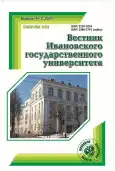Ceremonial Functions of the Praetorian Guard under the Principate
- Авторлар: Ivanova E.S.1
-
Мекемелер:
- Lobachevsky State University of Nizhny Novgorod
- Шығарылым: № 1 (2025)
- Беттер: 70-80
- Бөлім: History
- URL: https://journal-vniispk.ru/2219-5254/article/view/310936
- DOI: https://doi.org/10.46726/H.2025.1.10
- ID: 310936
Дәйексөз келтіру
Толық мәтін
Аннотация
The article is devoted to the ceremonial functions of the Praetorian Guard and their significance for the political culture of the Principate. In particular, the author studies state-dynastic ceremonies in order to see the visual manifestations of the Praetorians’ political role, that helps to understand the hidden mechanisms of power. To achieve this goal, the author applies the methodology of the performative turn, considering ceremonies and rituals as staged performances organized with a political aim for certain addressees. The author concludes that state-dynastic ceremonies with the Guard’s participation were important for legitimizing princeps’ power. For instance, acclamatio acted as the primary institutional ritual of providing the candidate for emperor with supreme power. At the same time, triumphus and adventus served as consensus rituals of support for the ruling regime and approval of its policies. The Praetorians’ leading role in these ceremonies shows that the guards’ position in the hierarchy of the imperial court was close to the senatorial and equestrian positions. For this reason, Guard’s opinion had a significant influence on political decision-making.
Негізгі сөздер
Авторлар туралы
E. Ivanova
Lobachevsky State University of Nizhny Novgorod
Хат алмасуға жауапты Автор.
Email: ivelina777@yandex.ru
Postgraduate student Nizhny Novgorod, Russia
Әдебиет тізімі
- Velikanova E.N. lnitiurn principis: the Procedure of Handing Over the Authority to the First Successors of Augustus, JAH, 2007, no. 3, pp. 163—174. — In Russ.
- Gus`kov E.A. Disbandment of the Praetorian Guard in 193 A.D., Izvestia of the Samara Scientific Center of the Russian Academy of Sciences. Historical Sciences, 2024, vol. 6, no. 1 (21), pp. 120—129. — In Russ.
- Makhlaiuk A.V. Soldiers of the Roman Empire. The Traditions of Military Service and the Martial Mentality, St. Petersburg, 2006, 440 p. — In Russ.
- Arena P. Imperator salutatus est. Rapporti tra salutationes imperatoriae e cerimonie da Caligola a Nerone, Il princeps romano: autocrate o magistrato? Fattori giuridici e fattori sociali del potere imperiale da Augusto a Commodo Commodo, a cura di J.-L. Ferrary, J. Scheid, Pavia, 2015, pp. 139—183.
- Balsdon J. The Emperor Gaius (Caligula), Oxford: Clarendon Press, 1934, 243 p.
- Benoist S. Rome, le prince et la Cité. Pouvoir imperial et cérémonies publiques (Ier siècle av. — début du IVe siècle apr. J.-C.), Paris: Presses Universitaires de France, 2005, 397 p.
- Bingham S. The Praetorian Guard. A History of Rome’s Elite Special Forces, London: I.B. Tauris, 2013, 240 p.
- De la Bédoyère G. Praetorian. The Rise and Fall of Rome’s Imperial Bodyguard, New Haven; London: Yale University Press, 2017, 336 p.
- Durry M. Les cohortes prétoriennes, Paris: E. de Boccard, 1938, 454 p.
- Flower H. Ancestor masks and aristocratic power in Roman culture, Oxford: Clarendon Press, 1996, 411 p.
- Gibson A.G.G. “All Things to All Men”: Claudius and the Politics of AD 41, The Julio-Claudian Succession: Reality and Perception of the “Augustan Model”, ed. by A. Gibson, Leiden; Boston: Brill, 2013, pp. 107—132.
- Kelly B. Violence and Security at Court, The Roman Emperor and his Court c. 30 BC—c. AD 300: vol. 1: Historical Essays, ed. by B. Kelly, A. Hug. Cambridge: Cambridge university press, 2022, pp. 371—394.
- Kerr J.L. The role and character of the praetorian guard and the praetorian prefecture until the accession of Vespasian: abstract of the dis. … Candidate of Sciences (History), Glasgow: University of Glasgow, 1991, 279 p.
- Kleijwegt M. Caligula's “Triumph” at Baiae, Mnemosyne, 1994, vol. 47, fasc. 5, pp. 652—671.
- Makhlaiuk A.V. Omnia deinde arbitrio militum acta: Political Initiative and Agency of the Army in Late-Republican and Early Imperial Rome, Leadership and Initiative in Late Republican and Early Imperial Rome, ed. by R. M. Frolov, C. Burden-Strevens, Leiden; Boston: Brill, 2022, pp. 457—488.
- McIntyre G. Making and Breaking Emperors: The cohors praetoria and the Transition of Imperial Power, Brill’s Companion to Bodyguards in the Ancient Mediterranean, Leiden, Boston: Brill, 2022, pp. 202—222.
- Ottley S. The Role Played by the Praetorian Guard in the Events of AD 69, as Described by Tacitus in his Historiae: abstract of the dis. … Candidate of Sciences (History), Perth: University of Western Australia, 2009, 273 p.
- Passerini A. Le coorti pretorie, Rome: Angelo Signorelli, 1939, 362 p.
- Price S. From noble funerals to divine cult: the consecration of Roman emperors, Rituals of Royalty: Power and Ceremonial in Traditional Societies, ed. by D. Cannadine, S. Price, Cambridge: Cambridge University Press, 1987, pp. 56—105.
- Rocco M. I pretoriani: soldati e cospiratori nel cuore di Roma, Rome: Salerno editrice, 2021, 200 p.
- Rollinger C. Changing the Guard: Guard Units and Roman State Ceremonial from the First to the Fourth Century, The Roman Imperial Court in the Principate and Late Antiquity, Oxford: Oxford University Press, 2023, pp. 56—74.
- Rollinger C. Specie Dominationis: The ‘Ceremonial’ Uses of Imperial Bodyguards under the Principate, Brill’s Companion to Bodyguards in the Ancient Mediterranean, Leiden; Boston: Brill, 2022, pp. 223—248.
- Smallwood E.M. Documents Illustrating the Principates of Gaius, Claudius and Nero, Cambridge: Cambridge university press, 1967, 147 p.
- Smith D.R. The DECVRSIO Sestertius Types of Nero and the Lusus Troiae, The Numismatic Chronicle, 2000, vol. 160, pp. 282—289.
- Wallace-Hadrill A. Civilis Princeps: Between Citizen and King, JRS, 1982, vol. 72, pp. 32—48.
Қосымша файлдар









